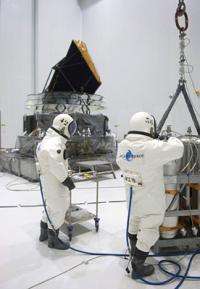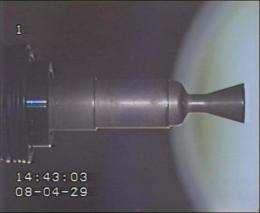'Green' satellite fuel designed to make space safer

(PhysOrg.com) -- On the day running up to launch when a spacecraft is fuelled, ground personnel look more like astronauts than engineers, putting on spacesuit-like protective gear.
This is an essential precaution when dealing with the current hydrazine fuel, but a new development could make satellite fuelling no more dangerous than filling up a car.
First used in rocket engines by the German Luftwaffe during World War Two, hydrazine remains the main propellant of choice for a satellite’s onboard thrusters, used for orbit correction or stationkeeping during its working life. It is a high-performing storable propellant that is also ‘hypergolic’ - meaning it ignites spontaneously on contact with oxidiser or by itself with a catalyst, which makes a spacecraft designer’s job a lot easier.
Unfortunately hydrazine is also highly corrosive and extremely toxic. When leaked into the environment, it degrades in a few days but has the potential to harm plants and marine life, while exposure is considered harmful to people at just 50 parts per million.
Seeking an alternative, ESA has been working with a company called ECAPS, part of the Swedish Space Corporation Group, to build and test a thruster that runs on a safer, more environmentally friendly fuel.
Officially called LMP-103S, this new fuel is a blend of ammonium dinitramide (ADN) with water, methanol and ammonia. ESA and the Swedish Space Corporation have been researching storable ADN-based liquid mono-propellants through a series of contracts since 1997. Details of their latest project, a 1-N ADN thruster intended for space applications, were unveiled at ESTEC’s Techno/Innovation Days in February.
“ADN has a 30% better performance than hydrazine, and is much less toxic,” said Mark Ford, Head of ESA’s Propulsion Engineering section. “Unlike hydrazine it is safe to transport by aircraft and can be worked with in shirt sleeves rather than protective suits.

“No energetic rocket fuel is ever going to be as benign as water, and we’re clearly not about to suddenly replace hydrazine completely but we hope to eventually provide industry with an acceptable alternative.
"Reducing the risk will lead to cheaper handling and a lower pricetag on missions. The ultimate aim is to enable the shipping of satellites from their factory with full fuel tanks - right now they are fuelled at their launch site at the very last moment, for safety reasons.”
While the propellant is new, the thruster design is quite conservative, explained Matthias Persson of ECAPS: “It follows a conventional monopropellant architecture using commercial-off-the-shelf fluid components with extensive flight heritage.
“It has performed well on the ground, and soon it will be tested in orbit: the High Performance Green Propellant (HPGP) 1 N motor system is flying as a technology demonstration aboard Sweden’s Prisma satellite, scheduled for launch later this year.
“We are already pleased to note that the Russian authorities at Prisma’s Yasny launch site have decided that fuelling the HPGP thruster is not defined as a hazardous operation, which will save significant time and money during the launch campaign. Compared to standard procedures, it will be more akin to filling a car at a petrol station.”
ESA has supported the HPGP thruster through a project in its General Support Technology Programme (GSTP), which aims to turn promising laboratory prototypes into flight-ready hardware. A follow-up GSTP project beginning later this year will qualify the new hardware in parallel to its flight aboard Prisma. The new thruster is also being considered for ESA’s formation flying test mission, Proba-3.
Provided by European Space Agency




















